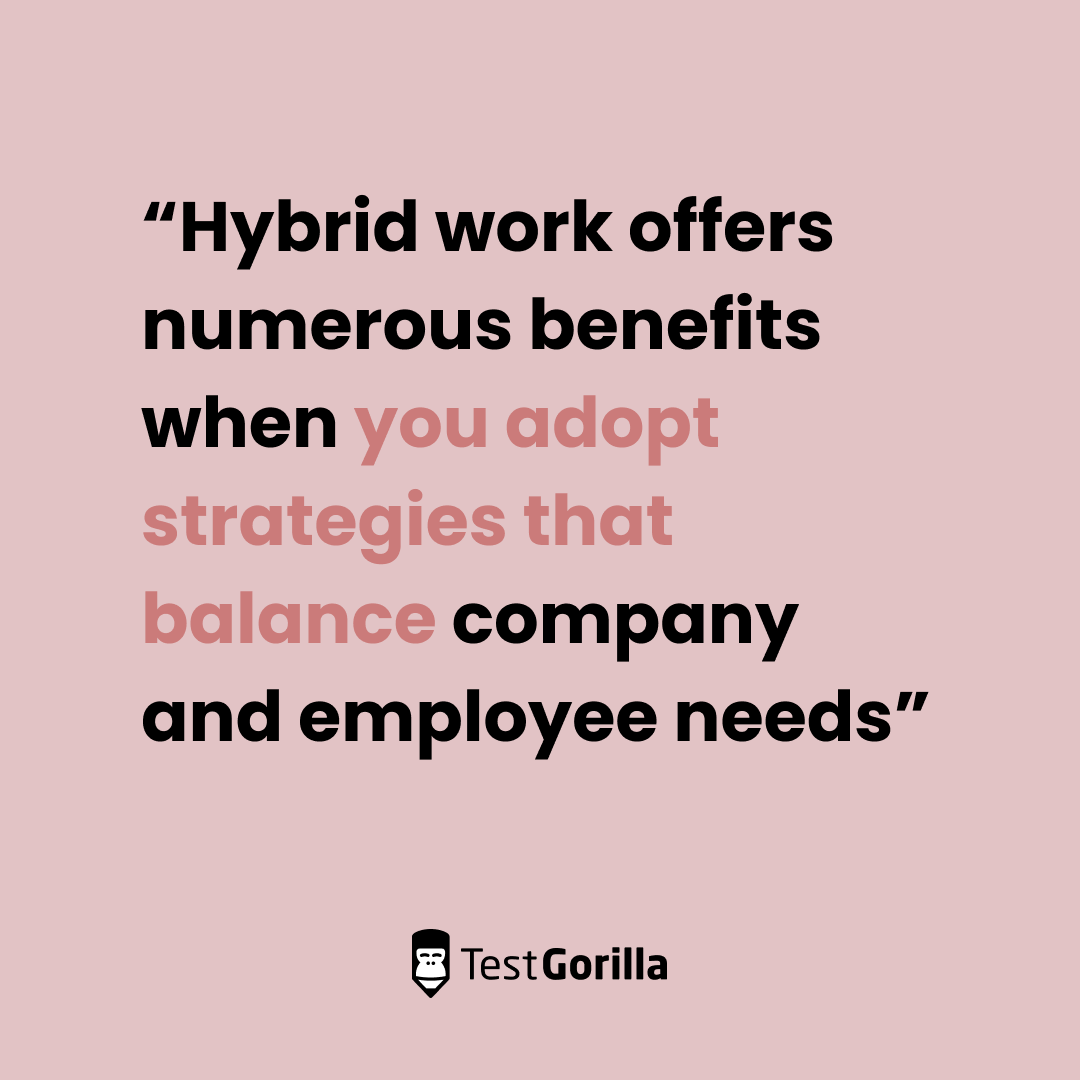Hybrid working – once viewed as the groundbreaking future of work – is on the brink of collapse. A recent survey found that 90% of companies plan to bring employees back into the office by the end of 2024 in an attempt to increase productivity and revenue. [1]
Many leaders are ready to threaten employees with dismissal if they don’t comply with return-to-office plans. But the BBC has shared that 50% of US employees would rather resign than be forced to return to office full time. [2] The situation is becoming increasingly messy.
Our stance? Hybrid working can be successful… with the right strategies. You must find a strategy that works for your business and your employees.
In this article, we share five hybrid work strategies to help you boost productivity, offer flexibility, and retain your top talent.
What is hybrid working?
First, let’s quickly recap what hybrid working means.
Hybrid working refers to a flexible work arrangement that supports a mixture of in-office and remote work. Companies can create various hybrid work models – for instance, three days in the office and two days remote.
Companies adopting hybrid working need access to technology and infrastructure that supports remote collaboration, physical office space for in-office days, and a company culture that values remote and in-person working equally.
The pros and cons of hybrid working
Hybrid working can be a mixed bag of benefits and drawbacks.
Pros
Some proven benefits include:
Enhanced employee productivity. A survey of 800 HR leaders found that 94% of employees were equally or more productive with remote working compared to office-based working.
Improved employee well-being and retention. Another survey of 28,000 full-time employees shows that roughly 79% of respondents felt hybrid work had improved their work-life balance and mental well-being.
Cost-savings. Estimates show that hybrid work could save companies roughly $11,000/employee annually through reduced rent, overheads, and other costs.
Increase access to talent. Hybrid jobs attract more diverse candidates – like working mothers looking for flexibility. Moreover, hybrid working partly removes location constraints: Candidates from further locations may be more open to commuting to work for a few days rather than every day of the week.
Cons
You may face these issues without the right hybrid work strategy:
Reduced productivity. Although some workers find hybrid work improves their productivity, others struggle to work from home (for instance, due to experiencing distractions).
Communication and technology hurdles. In a 2021 survey, 58% of respondents indicated that technical or software issues – like unclear audio or video quality and Wi-Fi issues – were among the biggest challenges of virtual communication.
Poor team cohesion. Research indicates that the social separation of remote and office employees can make forming strong interpersonal bonds challenging and impact collaboration.
Cybersecurity risks. A dependence on technology puts companies at increased risk of cyberattacks, fraud, data breaches, and so on. One consulting firm found that ransomware attacks and other risks were up 53% during the pandemic.
The best insights on HR and recruitment, delivered to your inbox.
Biweekly updates. No spam. Unsubscribe any time.
Why are employers struggling to fix their problems with hybrid work?
We believe some employers take their hybrid work strategies to an extreme, favoring either their businesses or employees. A sound hybrid work strategy is one that meets the needs of both. We’ve outlined five of these below.
What makes hybrid work successful? 5 strategies
In order to address this struggle, we’ve put together 5 strategies for making hybrid work successful:
Tailor your strategy to different personas
Don’t stalk your employees
Choose quality over quantity in meetings and social interactions
Prevent cognitive biases and discrimination
Adopt only essential security measures and train your employees
1. Tailor your strategy to different personas
A recent study found that 56% of companies with hybrid work offer an “at-will policy” – allowing employees to choose where they want to work based on their needs. This strategy can quickly put business needs at risk.
For instance, research shows that given the choice, most employees want to work remotely on Mondays and Fridays, reducing office coverage on these days. Alternatively, some companies control their hybrid model – for example, by making everyone come to the office on Mondays, Wednesdays, and Fridays. This takes the “flexibility” out of hybrid working and doesn’t consider individual needs.
What to do
Our solution draws inspiration from the ingenious approach taken by Equinor, a Norwegian energy company.
Use surveys to understand your employees’ needs and preferences. Based on the results, develop some “personas” to represent your employees. Then, design hybrid working structures tailored to the different personas and give employees the freedom to choose the structure that works best for them.
For instance, Sam – who commutes for over an hour to get to work – might choose two days in the office and three days at home. Meanwhile, Alex – who lives in a shared (and noisy) apartment – could opt to come in every day.
If an employee struggles with performance in their chosen model, you can discuss alternative options.
You might add a single in-office daymeet where employees must be available regardless of work location. This considers employees’ needs while establishing some (but not too much) structure and control.
2. Don’t stalk your employees
Some companies use invasive monitoring tools to track employees’ productivity during their remote days. This includes screen recording, activity tracking, email and communication monitoring, and excessive check-ins.
This approach can seriously backfire. A 2022 study found that electronic monitoring decreased job satisfaction, increased stress, and didn’t improve performance. Companies like Google have even faced backlash for such measures.
This can lead to distrust and a negative work environment.
What to do
Focus on performance first. If a team member misses deadlines, makes mistakes, fails to reply to messages in a timely fashion, or falls behind their coworkers, take the same action you would for in-office performance issues or absences.
Provide them with feedback, offer training and coaching, and consider implementing a performance improvement plan.
3. Choose quality over quantity in meetings and social interactions
Many companies worry hybrid working will lead to diminished communication, collaboration, and team cohesion. To combat this, certain organizations deployed a variety of measures, such as:
Setting up an excessive number of meetings or making meeting attendance mandatory
Conducting important meetings in person for fear of technology failures
Conducting important meetings over video to ensure everyone can attend
Expecting remote employees to be available after work hours
Organizing too many team-building workshops and socials
These strategies can lead to more problems than they solve. For instance, too many virtual meetings can lead to “Zoom fatigue” and burnout.
What to do
Here’s how to improve communication and cohesion in hybrid teams.
Eliminate unnecessary meetings and use asynchronous communication for others. Harvard Business Review found this approach boosted productivity.
Conduct small meetings through video calls and large or critical meetings in person. A Stanford publication shows this improves engagement.
Invest in good communication technology – including high-quality audio and video conferencing platforms, instant messaging tools, high-storage shared drives, large screens, and quality microphones.
Invest in better office setups with great video conferencing tools and interactive whiteboards for equal in-person and remote engagement.
Set communication guidelines – for example, a virtual “closed door policy” where remote employees can switch their statuses to offline at day’s end to foster work-life balance.
Conduct team building sessions no more than once per quarter so employees don’t burn out.
Host socials only when there’s a reason to – for instance, holiday parties or company milestone celebrations. Where possible, have these events in person so employees can regroup and have high-quality interactions.
4. Prevent cognitive biases and discrimination
Hybrid working models are prone to certain cognitive biases that favor in-office employees over remote employees.
Here’s what to look out for.
Proximity bias happens when you favor employees near you – for instance, those with you in the office over those working remotely. One study found that employees physically present in the office are offered better opportunities than those working remotely.
Affinity bias represents the tendency to favor employees who are similar to you or have the same thought process as you. The World Economic Forum showed that senior managers preferred the idea of office work. The affinity bias might lead them to prioritize in-office workers.
Some companies have also started using monetary incentives to lure employees into working more from the office. This punishes women, who are more likely to work remotely.
What to do
Promote fair treatment and opportunities for all by:
Creating a clear performance evaluation process with objective criteria to assess employees’ performances. Use this for key decisions regarding things like promotions and pay raises.
Providing unconscious bias training to all managers and company leaders.
Offering training, mentoring, and coaching to help employees adapt their working styles and communication skills to both office-based and remote work.
5. Adopt only essential security measures and train your employees
To fight security threats associated with remote working, some companies use excessive security measures – including unnecessary permission and access controls, extremely complex password policies, and frequent security checks.
While some security measures are necessary to protect your company, too many can result in employee frustration, fatigue, decreased productivity, and less innovation.
What to do
Speak to your in-house IT team or external consultants to understand the security vulnerabilities that apply to your company and the measures essential to protecting you against cybersecurity threats. Adopt only necessary measures.
Additionally, if you can afford it, provide employees with work laptops and mobile devices for remote work. Otherwise, ask them to use secure remote access software like Citrix or AnyDesk.
Finally, training and testing your employees' knowledge on cybersecurity is great for protection without excessive firewalls and controls. Teach them about phishing awareness, password best practices, safe internet use, incident reporting, and more.
Nail hybrid working with the right hybrid work strategy
Hybrid work offers numerous benefits when you adopt strategies that balance company and employee needs. So don’t discount hybrid working if you don’t yet use it, and don’t make employees return to the office full-time if you do.
Instead, use personality testing to create hybrid models that suit different employees’ preferences. Limit unnecessary meetings. And train employees and managers on biases and security vulnerabilities. These methods can help you achieve a good balance in your hybrid work strategy.
After all, hybrid work is about more than flexibility: It’s about creating a future where productivity, innovation, and well-being can thrive simultaneously.
Sources
“90% of companies will return to office by the end of 2024”, Resume Builder (2023) https://www.resumebuilder.com/90-of-companies-will-return-to-office-by-the-end-of-2024/
Brian Lufkin, “The workers quitting over return to office policies”, BBC (2022) https://www.bbc.com/worklife/article/20220523-the-workers-quitting-over-return-to-office-policies
You've scrolled this far
Why not try TestGorilla for free, and see what happens when you put skills first.

















